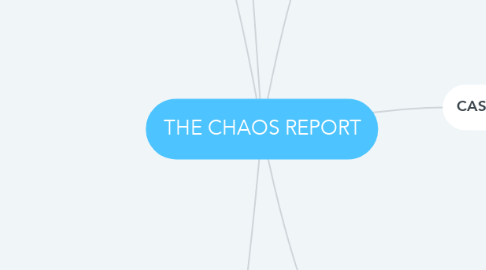
1. METHODOLOGY
1.1. The survey
1.1.1. was as thorough as possible, short of the unreachable goal of surveying every company with MIS in the country
1.2. The results
1.2.1. are based on what we at The Standish Group define as "key findings" from our research surveys and several personal interviews
1.3. The respondents
1.3.1. segments
1.3.1.1. banking
1.3.1.2. securities
1.3.1.3. manufacturing
1.3.1.4. retail
1.3.1.5. wholesale
1.3.1.6. heath care
1.3.1.7. insurance
1.3.1.8. services
1.3.1.9. local, state, and federal organizations
1.4. The total sample size
1.4.1. total sample size was 365 respondents and represented 8,380 applications
1.5. Project classification
1.5.1. Resolution Type 1, or project success: The project is completed on-time and on-budget, with all features and functions as initially specified.
1.5.1.1. Success rate: 16.2%
1.5.2. Resolution Type 2, or project challenged: The project is completed and operational but over-budget, over the time estimate, and offers fewer features and functions than originally specified.
1.5.2.1. Rate of projects disability: 52.7%
1.5.3. Resolution Type 3, or project impaired: The project is canceled at some point during the development cycle.
1.5.3.1. Rate of deterioration (canceled): 31.1%
2. SUCCESS/FAILURE PROFILES
2.1. Project Success Factors
2.1.1. User Involvement (15.9%)
2.1.2. Executive Management Support (13.9%)
2.1.3. Clear Statement of Requeriments (13.0%)
2.1.4. Proper Planning (9.6%)
2.1.5. Realistic Expectations (8.2%)
2.1.6. Smaller Project Milestones (7.7%)
2.1.7. Competent Staff (7.2%)
2.1.8. Ownership (5.3%)
2.1.9. Clear Vision & Objetives (2.9%)
2.1.10. Hard-Working, Focused Staff (2.4%)
2.1.11. Other (13.9%)
2.2. Project Challenged Factors
2.2.1. Lack of User Input (12.8)
2.2.2. Incomplete requirements & Specifications (12.3%)
2.2.3. Changing Requirements & Specifications (11.8%)
2.2.4. Lack of Executive Support (7.5%)
2.2.5. Technology Incompetence (7.0%)
2.2.6. Lack of Resources (6.4%)
2.2.7. Unrealistic Expectations (5.9%)
2.2.8. Unclear Objectives (5.3%)
2.2.9. Unrealistic Time Frames (4.3%)
2.2.10. New Technology (3.7%)
2.2.11. Others (23.0%)
2.3. Project Impaired factors
2.3.1. Incomplete Requirements (13%)
2.3.2. Lack of User Involvement (12.4%)
2.3.3. Lack of Resources (10.6%)
2.3.4. Unrealistic Expectations (9.9%)
2.3.5. Lack of Executive Support (9.3%)
2.3.6. Changing Requirements & Specifications (8.7%)
2.3.7. Lack of Planning (8.1%)
2.3.8. Didn't Need It Any Longer (7.5%)
2.3.9. Lack of IT Management (6.2%)
2.3.10. Technology Illiteracy (4.3%)
2.3.11. Other (9.9%)
3. INTRODUCTION
3.1. One of the biggest reasons bridges come in on-time, on-budget and do not fall down is because of the extreme detail of design.
3.2. Therefore a more flexible model must be used. This could be and has been used as a rationale for development failure.
3.3. Consequently the focus of this latest research project at The Standish Group has been to identify:
3.3.1. The scope of software project failures
3.3.2. The major factors that cause software projects to fail
3.3.3. The key ingredients that can reduce project failures
4. FOCUS GROUPS
4.1. Four groups are created
4.1.1. Two in Boston
4.1.2. Two in San Francisco
4.2. Purpose
4.2.1. Ask for opinions on why projects fail
5. CASE STUDIES
5.1. Two famous type 3 resolution projects (canceled)
5.1.1. California DMV
5.1.1.1. 10 points
5.1.2. American Airlines
5.1.2.1. 29 points
5.2. Two draft resolutions type 1 (success)
5.2.1. Hyatt Hotels
5.2.1.1. 100 points
5.2.2. Banco Itamarati
5.2.2.1. 85 points
5.3. Success Criteria
5.3.1. Executive Management Support (16 points)
5.3.2. Clear Statement of Requirements (15 points)
5.3.3. Proper Planning (11 points)
5.3.4. Realistic Expectations (10 points)
5.3.5. Smaller Project Milestones (9 points)
5.3.6. Competent Staff (8 points)
5.3.7. Ownership (6 points)
5.3.8. Clear Vision & Objectives (3 points)
5.3.9. Hard-Working, Focused Staff (3 points)

